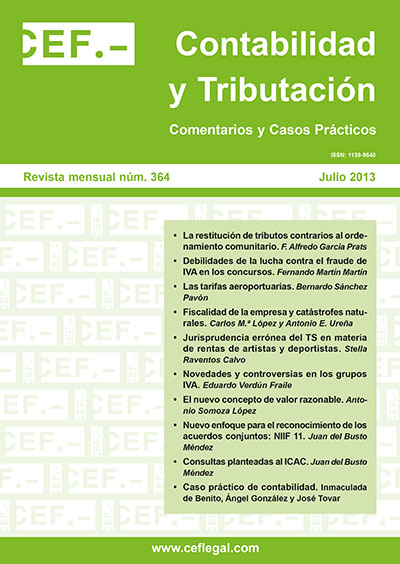El nuevo concepto de valor razonable en la normativa internacional: novedades e implicaciones prácticas
DOI:
https://doi.org/10.51302/rcyt.2013.6423Palabras clave:
IASB, NIIF, NIC, valor razonable, valor de mercadoResumen
En enero de 2013 ha entrado en vigencia la NIIF 13 que establece el nuevo concepto de valor razonable. Dicha norma sustituye a la antigua, contenida sobre todo en la NIC 39 así como las dispersas referencias que sobre esta se daban en la normativa internacional. En este artículo se explican las características fundamentales del nuevo valor y se hacen algunas reflexiones en torno al concepto y su aplicación. En especial se subraya el incremento de la información a revelar, así como el necesario cambio que va a suponer para la profesión contable –así como para los usuarios en general– al ser un valor mucho más subjetivo y que incorpora mayores expectativas por parte de los gestores. Se concluye con algunos comentarios útiles acerca de su implantación práctica.
Descargas
Citas
Ahmed, A. S.; Kilic, E. y Lobo, G. J. [2006]: «Does recognition versus disclosure matter? Evidence from value-relevance of banks' recognized and disclosed derivative financial instruments», The Accounting Review, vol. 81, núm. 3, págs. 567-588.
Akgün, M.; Davut, P. y Meltem, G. [2011]: «A Process Design for Auditing Fair Value», International Journal of Economics and Finance, vol. 3, núm. 3, págs. 160-166.
Barth, M. E.; Landsman, W. R. y Wahlen, J. [1995]: «Fair value accounting: effects on banks' earnings volatility, regulatory capital, and value of contractual cash flows», Journal of Banking and Finance, vol. 18, núms. 3-4, págs. 577-605.
Bell, T. y Griffin, J. B. [2012]: «Commentary on Auditing High-Uncertainty Fair Value Estimates», Auditing, Feb, vol. 31, núm. 1, págs. 147-155.
Benston, G. J. [2008]: «The shortcomings of fair-value accounting described in SFAS 157», Journal of Accounting and Public Policy, vol. 27, págs. 101-114.
Cascini, K. T. y DelFavero, A. [2011]: «An evaluation of the implementation of fair value accounting: Impact On Financial Reporting», Journal of Business & Economics Research, vol. 9, núm. 1, págs. 1-16.
Cortese-Danile, T. M.; Mautz Jr., D. R. y McCarthy, I. M. [2010]: «Ethics is Imperative to Effective Fair Value Reporting: Weaving Ethics into Fair Value», Review of Business, vol. 30, núm. 2, págs. 50-58.
Chen, K.; Sommers, G. A. y Taylor, G. K. [2006]: «Fair Value's Affect on Accounting's Ability to Predict Future Cash Flows: A Glance Back and a Look at the Potential Impact of Reaching the Goal» disponible en http://www.papers.ssrn.com/sol3/papers.cfm?abstract_id=930702.
Christensen, B. E.; Glover, S. M. y Wood, D. A. [2012]: «Extreme Estimation Uncertainty in Fair Value Estimates: Implications for Audit Assurance», Auditing, vol. 31, núm. 1, págs. 127-146.
Davis-Friday, P. Y.; Folami, L. B.; Liu, C. S. y Mittelstaedt, H. F. [1999]: «The value relevance of financiancial statement recognition vs. disclosure: Evidence form SFAS n.º 106», The Accounting Review, vol. 74, núm. 4, págs. 403-423.
Fitzsimons, A. P.; Satenstein, J. L. y Silliman, B. R. [2010]: «Fair Value Audit Guidance of Public and Non-Public Companies in Response to the Credit Crisis», Review of Business, vol. 30, núm. 2, págs. 40-49.
IASB [2000]: NIC 39. Instrumentos financieros: reconocimiento y medición.
– [2011]: International Financial Reporting Standard 13.
– [2011a]: Norma Internacional de Información Financiera 13 (NIIF 13) traducción al español.
– [2011b]: NIIF 13 Fair Value Measurement Basis for Conclusions.
– [2011c]: NIIF 13 Fair Value Measurment Project Summary and Feedback Statement.
– [2012a]: NIIF 13 Fair Value Measurement Illustrative Examples.
– [2012b]: Illustrative Examples to accompany NIIF 13 Fair Value Measurement Unquoted equity instruments within the scope of NIIF 9 Financial Instruments.
Jaggi, B.; Winder, J. P. y Lee, C. F. [2010]: «Is There a Future for Fair Value Accounting After the 2008-2009 Financial Crisis?», Review of Pacific Basin Financial Markets & Policies, vol. 13, núm. 3, págs. 469-493.
Karstetter, E. y Lien, M. [2009]: «Tactical Implementation of Fair Value Rules», Financial Executive, vol. 25, núm. 10, págs. 30-34.
King, A. [2009]: «Determining Fair Value», Strategic Finance, vol. 90, núm. 7, págs. 27-32.
Laux, C. y Leuz, C. [2009]: «The crisis of fair-value accounting: Making sense of the recent debate», Accounting, Organizations and Society, núm. 34, págs. 826-834.
Magnan, M. [2009]: «Fair Value Accounting and the Financial Crisis: Messenger or Contributor?», Accounting Perspectives, vol. 8, núm. 3, págs. 189-213.
Milburn, J. A. [2008]: «The Relationship between Fair Value, Market Value, and Efficient Markets», Accounting Perspectives, vol. 7, núm. 4, págs. 293-316.
Penman, S. [2007]: «Financial reporting quality: is fair value a plus or a minus?», Accounting and Business Research, Special Issue: International Accounting Policy Forum, págs. 33-44.
Plantin, G.; Sapra, H. y Shin, H. S. [2008]: «Marking-to-market: Panacea or Pandora's box?», Journal of Accounting Research, vol. 46, núm, 2, págs. 435-460.
Power, M. [2010]: «Fair value accounting, financial economics and the transformation of reliability», Accounting and Business Research, vol. 40, núm. 3, págs. 197-210.
Schmidt, S. [2004]: «Fair value accounting», International Association of Credit Portfolio Managers General Meeting, November 28. Disponible en http://www.fasb.org/ocl/1201-100/31186.pdf
Schmidt, M. [2009]: «Fair Value: Your Value or Mine? An Observation on the Ambiguity of the Fair Value Notion Illustrated by the Credit Crunch», Accounting in Europe, 2009, vol. 6, núm. 2, págs. 271-282.
Whittington, G. [2008]: «Fair Value and the IASB/FASB Conceptual Framework Project: An Alternative View», Abacus, vol. 44, núm. 2, págs. 139-168.
















